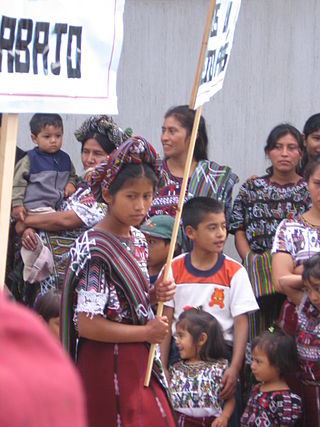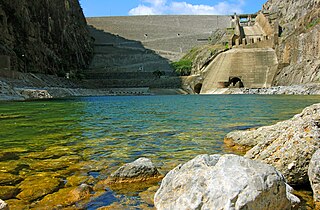Related Research Articles

Santa Cruz del Quiché is a city, with a population of 78,279, in Guatemala. It serves as the capital of the El Quiché department and the municipal seat of Santa Cruz del Quiché municipality. The city is located at 15.03°N 91.15°W, at an elevation of 2,021 m above sea level. It has an airport, Quiché Airport, located just south of the city.
The Dos Erres massacre of 6 December 1982 took place in Dos Erres, a small village in the municipality of La Libertad, in the northern Petén department of Guatemala. The name of the village, occasionally given as "Las Dos Erres", literally means "two Rs", originating from two brothers called Ruano who received the original land grant.
In 1994 Guatemala's Commission for Historical Clarification - La Comisión para el Esclarecimiento Histórico (CEH) - was created as a response to the thousands of atrocities and human rights violations committed during the decades long civil war that began in 1962 and ended in the late 1990s with United Nations-facilitated peace accords. The commission operated under a two-year mandate, from 1997 to 1999, and employed three commissioners: one Guatemalan man, one male non-national, and one Mayan woman. The mandate of the commission was not to judge but to clarify the past with "objectivity, equity and impartiality."

Panzós is a town with a population of 22,068 and a municipality in the Guatemalan department of Alta Verapaz.

Chajul is a town and municipality in the Guatemalan department of El Quiché. Chajul is part of the Ixil Community, along with San Juan Cotzal and Santa María Nebaj. The Ixil region is isolated by beautiful mountains and has maintained its rich Ixil Maya traditions and language. Chajul, Nebaj, and Cotzal make up the Ixil Region in the Department of Quiché in the Western Highlands of Guatemala. Having been at the heart of the 36-year civil war, Chajul experiences post-war challenges such as emotional trauma, land displacement, and fragmented families. Additionally, unemployment is high, large families live in one-room adobe houses with open cooking fires, opportunities for women are scarce, and family- and gender-based violence are common. The community has a corn-based agricultural economy in which adults struggle daily to feed their families and the average income is $1–3 per day. A 2002 study revealed that less than 1% of children graduate from high school as they are forced to leave school at a young age to help support the family household, leaving 75% of the adult population illiterate. Chajul further suffers from common preventable health concerns, such as respiratory illness, intestinal disease, tuberculosis, malnutrition, and death during childbirth. Eighty percent of the Chajul population lives in poverty.
Santa María Cunén is a town and municipality in the El Quiché department of Guatemala. The municipality covers 195 km2. At an average altitude of 1,827 metres above sea level, its climate is temperate. It is located 68 km from the departmental capital, Santa Cruz del Quiché, as measured by paved road. Tourist attractions include Las Grutas and the El Chorro waterfall.

Sacapulas is a town and municipality in the Guatemalan department of El Quiché.
San Andrés Sajcabajá is a municipality in the Guatemalan department of El Quiché. The municipality is formed by the town San Andrés Sajcabajá, and 62 rural communities. The majority (89%) of its population is ethnic K'iche'.
La Libertad is a municipality in the El Petén department of Guatemala. It contains 79,416 people and has abundant oil reserves that have been commercialized by international oil companies since the 1980s.
El Estor is a town and a municipality in the Izabal department of Guatemala. As of the 2018 census, the town's population was 20,489. The population of El Estor consists largely of Qʼeqchiʼ speaking indigenous people.

The Guatemalan Civil War was a civil war in Guatemala which was fought from 1960 to 1996 between the government of Guatemala and various leftist rebel groups. The Guatemalan government forces committed genocide against the Maya population of Guatemala during the civil war and there were widespread human rights violations against civilians. The context of the struggle was based on longstanding issues of unfair land distribution. Wealthy Guatemalans, mainly of European descent and foreign companies like the American United Fruit Company had control over much of the land. They paid almost zero taxes in return–leading to conflicts with the rural indigenous poor who worked the land under miserable terms.
Irma Flaquer Azurdia was a Guatemalan psychologist and reporter known for her pointed critiques against the Guatemalan government.
Manuel Colom Argueta was mayor of Guatemala City and an important progressive leader of the opposition in Guatemala.
Alberto Fuentes Mohr was a Guatemalan economist and politician, one of the founders of the Social Democratic Party. He also served as Minister of Finance and foreign minister during the 1960s.

Ixcán is a municipality in the Guatemalan department of El Quiché. Its administrative centre is the town of Playa Grande. The municipality consists of 176 communities, called aldeas. It has an area of 1,693 km2. It is the northernmost municipality of El Quiché, and borders with Mexico, the municipalities of Chisec and Cobán of the Department of Alta Verapaz, the municipality of Santa Cruz Barillas of the Department of Huehuetenango, and the municipalities of Chajul and Uspantán of El Quiché.

The Ixil are a Maya people located in the states of Campeche and Quintana Roo in Mexico and in the municipalities of Santa María Nebaj, San Gaspar Chajul, and San Juan Cotzal in the northern part of the Cuchumatanes mountains of the department of Quiché, Guatemala. These three municipalities are known as the Ixil Triangle and are the place of origin of the Ixil culture and where the majority of the population lives.

The Chixoy Dam is a reinforced concrete dam and power plant spanning the Chixoy River between the Departments of Baja Verapaz, El Quiché and Alta Verapaz, Guatemala. It is the largest structure of its kind in the country.

The Guatemalan genocide, also referred to as the Maya genocide, or the Silent Holocaust, was the mass killing of the Maya Indigenous people during the Guatemalan Civil War (1960–1996) by successive Guatemalan military governments that first took power following the CIA instigated 1954 Guatemalan coup d'état. Massacres, forced disappearances, torture and summary executions of guerrillas and especially civilians at the hands of security forces had been widespread since 1965, and was a longstanding policy of the military regime. Human Rights Watch (HRW) has documented "extraordinarily cruel" actions by the armed forces, mostly against civilians.

The Franja Transversal del Norte is a region in Guatemala delimited to the north by an imaginary line between Vértice de Santiago in Huehuetenango and Modesto Méndez Port in Izabal and in the south by La Mesilla in Huehuetenango and Izabal lake. It is composed, from west to east, of part of the Guatemalan departments of Huehuetenango, Quiché, Alta Verapaz and the entire department of Izabal. It extends roughly 15750 km2. During the Guatemalan Civil War, most of the massacres took place there due to the oil, mineral and precious wood reserves in the region. In the 21st century, there are projects to work in the region and a modern highway was built in 2010.
References
- ↑ Edward T. and Donna Whitson Brett, The Bill Woods Story: Maryknoll Missionary in Guatemala. Maryknoll.
- ↑ Comisión de Esclarecimiento Histórico (CEH) (1999). "Caso ilustrativo No. 101. Ejecución arbitraria del Padre Eufemio Hermógenes López Coarchita". Guatemala: Memoria del silencio (First ed.). Guatemala. ISBN 99922-54-00-9.
{{cite book}}: CS1 maint: location missing publisher (link) - 1 2 3 4 5 6 ODHAG. "Testigos de la fe por la paz Vidas ejemplares de la Iglesia Católica de Guatemala" (PDF). Oficina de Derechos Humanos del Arzobispado de Guatemala (ODHAG). Archived from the original (PDF) on 2011-07-21. Retrieved 2010-05-10.
- 1 2 Comisión de Esclarecimiento Histórico (CEH) (1999). "Caso ilustrativo no. 56. Ejecución del sacerdote Walter Voordeckers". Guatemala: Memoria del silencio (First ed.). Guatemala. ISBN 99922-54-00-9.
{{cite book}}: CS1 maint: location missing publisher (link) - ↑ Ginger Thompson (November 21, 2005). "Mildewed Police Files May Hold Clues to Atrocities in Guatemala". The New York Times . Retrieved 2010-05-13.
- 1 2 3 4 5 Comisión de Esclarecimiento Histórico (CEH) (1999). "La ruptura del tejido social". Guatemala: Memoria del silencio (First ed.). Guatemala. ISBN 99922-54-00-9.
{{cite book}}: CS1 maint: location missing publisher (link) - 1 2 3 Harbour, Berna G. (29 March 2000). "Testimonios españoles de una tragedia". El País.
- 1 2 3 4 Pedraz, D. Santiago (22 November 2006). "Auto de extradicción, Juzgado Central de Instrucción Número uno de la Audiencia Nacional. Madrid" (PDF). Administración de Justicia, Madrid. Archived (PDF) from the original on 2 June 2010. Retrieved 10 May 2010.
- 1 2 3 4 "QUERELLA DE RIGOBERTA MENCHU ANTE LA AUDIENCIA NACIONAL" (in Spanish). lasnoticiasmexico.com. Archived from the original on 2009-03-26. Retrieved 2010-05-14.
- ↑ Comisión de Esclarecimiento Histórico (CEH) (1999). "Caso ilustrativo No. 79 - La masacre en la embajada de España". Guatemala: Memoria del silencio (First ed.). Guatemala. ISBN 99922-54-00-9.
{{cite book}}: CS1 maint: location missing publisher (link) - 1 2 3 "Los sacerdotes, testigos de la fe, en Guatemala" (in Spanish). iglesiacatolica.org. 4 August 2009. Retrieved 26 May 2010.
- ↑ "Priests Shot To Death". Sarasota Herald-Tribune . May 21, 1981. Retrieved 2010-05-13.
- ↑ Comisión de Esclarecimiento Histórico (CEH) (1999). "Las ejecuciones arbitrarias". Guatemala: Memoria del silencio (First ed.). Guatemala. ISBN 99922-54-00-9.
{{cite book}}: CS1 maint: location missing publisher (link) - ↑ Frati Minori del Veneto e Friuli. "Padre Tullio Maruzzo, martire in Centro America". Archived from the original on 2011-07-22. Retrieved 2010-05-18.
- ↑ Ufficio Diocesano per la Pastorale Missionaria - Vicenza. "Padre Tullio Marcello Maruzzo dei frati minori" (PDF). Archived from the original (PDF) on 2016-03-04. Retrieved 2010-05-18.
- 1 2 "Report On The Situation of Human Rights In The Republic Of Guatemala". Inter-American Commission on Human Rights. 13 October 1981. Retrieved 26 May 2010.
- ↑ Comisión de Esclarecimiento Histórico (CEH) (1999). "Caso ilustrativo no. 12. Persecución de Católicos en Santiago Atitlán". Guatemala: Memoria del silencio (First ed.). Guatemala. ISBN 99922-54-00-9.
{{cite book}}: CS1 maint: location missing publisher (link) - ↑ "Guatemala: Requiem for a Missionary". Time. August 10, 1981. Archived from the original on October 15, 2010. Retrieved 2010-05-13.
- ↑ "Sainthood proposed for slain priest". Chicago Tribune. September 28, 2007. Retrieved 2010-05-13.
- ↑ "AROUND THE WORLD; 3 Seized in Guatemala In Slaying of U.S. Priest". The New York Times . August 5, 1981. Retrieved 2010-05-13.
- ↑ "Br. Santiago Miller". De La Salle Brothers. Archived from the original on February 12, 2018. Retrieved February 11, 2018.
- ↑ Ana J. Morales Ramírez. 2005. Semblanza del "Mártir de la Caridad" Fray Augusto Ramírez Monasterio. Guatemala: Provincia Franciscana “Nuestra Señora de Guadalupe de Centroamérica y Panamá”.
- ↑ Gygax, Eduard (20 November 2007). "Aceptan abrir proceso para beatificar a guatemalteco". El Periódico. Archived from the original on 17 July 2011.